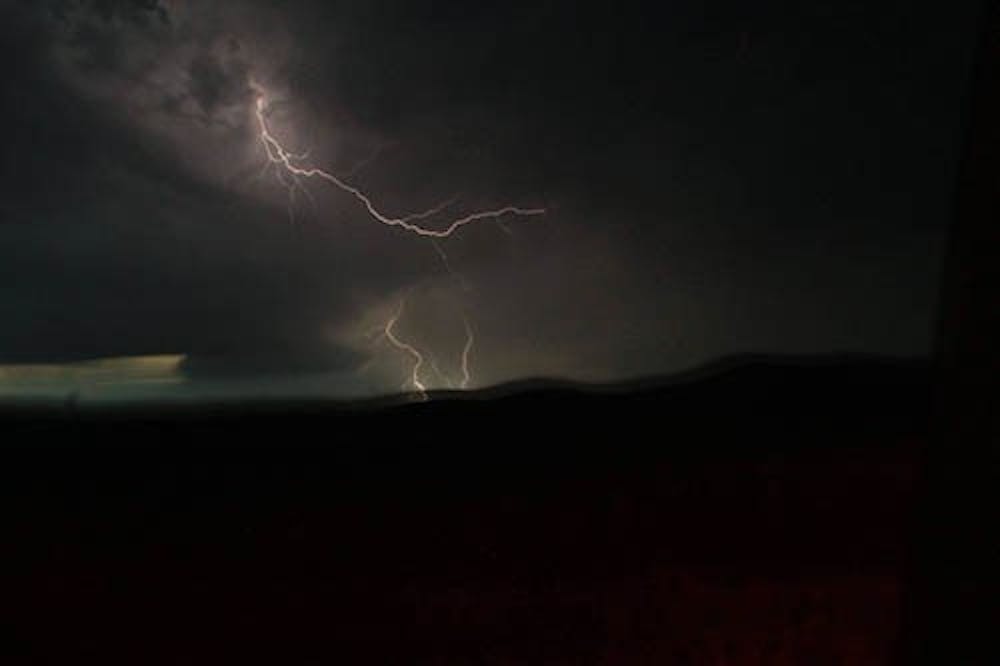A Ball State professor and his eight students were eager to see tornadoes last week in Texas, but hearing of the tragedies that resulted made it a “bittersweet” experience.
David Call, a meteorology professor who leads Ball State’s storm chasing class with geography professor Reuben Allen, said seeing transformers explode and the size of the tornado were the first hints of the destruction it was causing.
“You can’t gauge a tornado’s destruction by its size, but obviously when you see a very wide tornado, it’s going to affect a bigger number of people and make it more likely that people will be killed or injured,” he said. “This was the most destructive tornado that I’ve ever seen.”
The trip is part of the “Field Observation of Severe Local Storms” class, and spans across the plains of the United States, including Texas, Nebraska and Kansas. It costs around $3,000 for the class and trip, and students must pay for their own meals, but Call said the trip gets students out of “windowless rooms” to really experience storms.
“This trip is somewhat like when people go to camp or other isolated environments,” he said. “When we get students out of their normal environments, they have nothing to focus on but the weather and forecasting and this class.”
David Stefl, a graduate student in atmospheric sciences who is currently on the trip, said the experience has been a blast and he has learned a lot so far.
“There’s only so much you can learn in a classroom, and really getting out in the field and forecasting these things every day and going to search for them really puts into practice what we’ve learned in the classroom,” he said. “I figured if I’m going to be dealing with this stuff for the rest of my life every day, it might be good if I had a handle on exactly what it looks like, exactly how they act in the field.”
Call said the trips tend to begin with him leading the group, but as students get a stronger hold on the information, he recedes into the background.
“Some of the days that have been the most memorable have been the days when I’ve been wrong and the students have been right, when I’ve thought we should do one thing and they’ve thought we should do another, and they’ve gotten it right,” he said.
Call said there is another major difference between normal classes and this one.
“In this class, there are no clear answers,” Call said. “Here, we get up in the morning and think we know where the storms are going to be, but they often surprise us and form in different areas we didn’t expect. There are times when I’m not sure what to do myself.”
Call has led the class since 2008. He saw his first tornado in western Kansas on the first trip.
“It sounded like a great opportunity to apply my meteorological training,” he said. “A lot of our students have been really enthusiastic about it.”
One such student is Stefl, who said the most exciting part of the trip was when they saw their first tornado.
“We were driving down the road and really not paying attention to what the storm was looking like. We were looking at radar trying to get to a certain spot to get a good viewing angle on it,” he said. “All of the sudden, right to our left on the car, a tornado just pops up.”
He said fear wasn’t his initial reaction, an adrenaline rush was.
“I remember talking to some of my classmates that I had so much adrenaline that I was going to have trouble sleeping that night,” Stefl said.
He said the tornado was roughly five miles from the group, so it didn’t pose much of a threat.
Call said the tornadoes are often the least of their worries.
“There are a lot of other things that we encounter that are a lot more hazardous than tornados,” he said. “The fact that we drive thousands of miles is one. I’ve logged 50,000 miles now on these chase trips. When you log that many miles, you’re going to encounter wild animals, sleepy truckers and drivers that pull in front of you without warning. I’m not so worried about a tornado hitting us as I’m worried about us being swamped by water or bashed by hail.”
Call said there have been some trips with very little activity.
“We’re really at the mercy of the weather pattern,” he said. “Last year the weather pattern was terrible. We had that drought which pushed all the storms to the fringes of the plains and made it difficult for them to form any type of tornadic activity.
“This week was pretty interesting. We started out the week pretty down, but the pattern has done a 180 and become very active. It’s been a week of highs and lows.”
Call said the trip is a great chance to see some of the extremes of weather.
“The storms themselves are really pretty out here. I mean, they’re destructive, but they’re also amazing and beautiful,” he said. “You don’t generally don’t see storms this photogenic out in the Midwest, they just don’t grow as large as they do in the Great Plains.”
But Call said they don’t forget about what tornadoes are capable of.
“It’s great to see tornadoes, but we only want to see them in areas where there aren’t people,” he said. “A lot of us have gone into this field because we want to help protect people by issuing warnings and other weather information to let them know what to do, and this is a reminder of how important that job is.”


